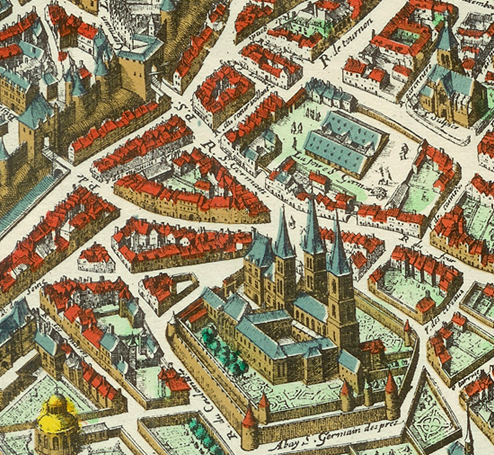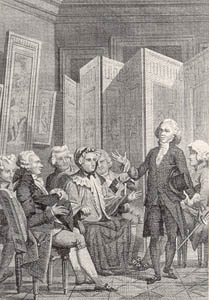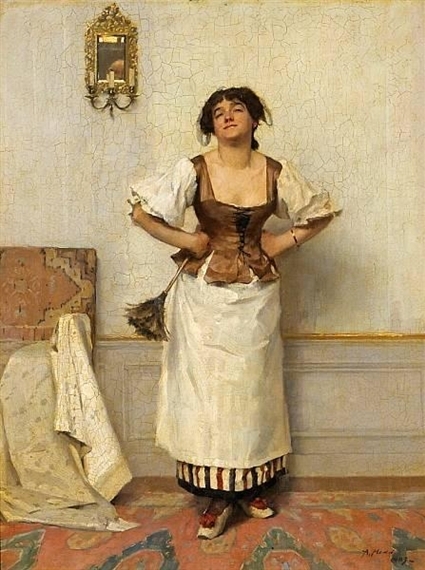|
Quinault Family
The Quinault family were French actors, active in the first half of the 18th century. * Jean Quinault was the father of this family. He was born at Bourges around 1656 or 1658, and died before June 1728. Said to be the son of a doctor from Issoudun, he joined an acting company based in Rouen called the ''troupe du Dauphin'' in 1679 and again in 1681. In Amiens in 1686 he married Marie Saintelette, daughter of a baker from Verdun. In March 1694 he and his wife joined the troupe of Leopold, Duke of Lorraine; the following year he auditioned for the Comédie-Française and was accepted for a quarter-share position. Instead of remaining in Paris, however, he returned to Lorraine and headed the duke's troupe from 1695 to 1705. Typically of provincial actors at the time, he led an itinerant life; various documents place him in Boulogne-sur-Mer in 1697; in Metz in 1688, 1698 and 1701; in Verdun in 1693; in Strasbourg in 1699 and 1702, in Nancy in 1699; in Marseille in 1705; and in 1727 in ... [...More Info...] [...Related Items...] OR: [Wikipedia] [Google] [Baidu] |
Jean Quinault
Jean may refer to: People * Jean (female given name) * Jean (male given name) * Jean (surname) Fictional characters * Jean Grey, a Marvel Comics character * Jean Valjean, fictional character in novel ''Les Misérables'' and its adaptations * Jean Pierre Polnareff, a fictional character from ''JoJo's Bizarre Adventure'' Places * Jean, Nevada, USA; a town * Jean, Oregon, USA Entertainment * Jean (dog), a female collie in silent films * Jean (song), "Jean" (song) (1969), by Rod McKuen, also recorded by Oliver * Jean Seberg (musical), ''Jean Seberg'' (musical), a 1983 musical by Marvin Hamlisch Other uses * JEAN (programming language) * USS Jean (ID-1308), USS ''Jean'' (ID-1308), American cargo ship c. 1918 * Sternwheeler Jean, a 1938 paddleboat of the Willamette River See also *Jehan * * Gene (other) * Jeanne (other) * Jehanne (other) * Jeans (other) * John (other) {{disambiguation ... [...More Info...] [...Related Items...] OR: [Wikipedia] [Google] [Baidu] |
Autry-le-Châtel
Autry-le-Châtel () is a Communes of France, commune in the Loiret Departments of France, department in north-central France. There is the church of Saint-Etienne, in the center of the village; it is a catholic church. There is also a castle. A famous cheese in this region is the Crottin de Chavignol. If you want to buy it, you can go near Autry in different farms (for example, Le Grand Bardelet farm). Geography The commune of Autry-le-Châtel is located in the southeast of the department of Loiret, in the agricultural region of Berry. It is located 62.1 km from Orléans, prefecture of the department, 45.8 km from Montargis, sub-prefecture, and 11.4 km from Châtillon-sur-Loire. The nearest municipalities are: Cernoy-en-Berry (7.7 km), Saint-Martin-sur-Ocre (8 km), Saint-Brisson-sur-Loire (8.1 km), Coullons (8.7 km) km), Poilly-lez-Gien (8.9 km), Blancafort (9.1 km, in the Cher), Saint-Firmin-sur-Loire (10.2 km), Gien (10.6&nbs ... [...More Info...] [...Related Items...] OR: [Wikipedia] [Google] [Baidu] |
Valenciennes
Valenciennes (, also , , ; nl, label=also Dutch, Valencijn; pcd, Valincyinnes or ; la, Valentianae) is a commune in the Nord department, Hauts-de-France, France. It lies on the Scheldt () river. Although the city and region experienced a steady population decline between 1975 and 1990, it has since rebounded. The 1999 census recorded that the population of the commune of Valenciennes was 41,278, and that of the metropolitan area was 399,677. History Before 1500 Valenciennes is first mentioned in 693 in a legal document written by Clovis II (''Valentiana''). In the 843 Treaty of Verdun, it was made a neutral city between Neustria and the Austrasia. Later in the 9th century the region was overrun by the Normans, and in 881 the town passed to them. In 923 it passed to the Duchy of Lower Lotharingia dependent on the Holy Roman Empire. Once the Empire of the Franks was established, the city began to develop, though the archaeological record has still not revealed all it has to ... [...More Info...] [...Related Items...] OR: [Wikipedia] [Google] [Baidu] |
Théâtre De La Foire
Théâtre de la foire is the collective name given to the theatre put on at the annual fairs at Abbey of Saint-Germain-des-Prés, Saint-Germain and Saint-Laurent church, Paris, Saint-Laurent (and for a time, at Saint-Ovide) in Paris. Foire Saint-Germain The earliest references to the annual fair date to 1176. The fairground itself was established in 1482 by Louis XI for the benefit of the Abbey of Saint-Germain-des-Prés and was located near the Abbey on the Rive Gauche, Left Bank southwest of the city center just outside one of the gates of the Wall of Philip II Augustus, Paris, city wall built by Philip II at the beginning of the 13th century. The covered Saint-Germain market today occupies part of the former fairground site with access from the Boulevard Saint-Germain via the Rue de Montfaucon satellite view. The fair generally lasted three to five weeks around Easter. During the 18th century it consistently opened on 3 February and lasted until Palm Sunday. The fair's first a ... [...More Info...] [...Related Items...] OR: [Wikipedia] [Google] [Baidu] |
Saint-Germain-en-Laye
Saint-Germain-en-Laye () is a commune in the Yvelines department in the Île-de-France in north-central France. It is located in the western suburbs of Paris, from the centre of Paris. Inhabitants are called ''Saint-Germanois'' or ''Saint-Germinois''. With its elegant tree-lined streets it is one of the more affluent suburbs of Paris, combining both high-end leisure spots and exclusive residential neighborhoods (see the Golden Triangle of the Yvelines). Saint-Germain-en-Laye is a sub-prefecture of the department. Because it includes the National Forest of Saint-Germain-en-Laye, it covers approximately , making it the largest commune in the Yvelines. It occupies a large loop of the Seine. Saint-Germain-en-Laye lies at one of the western termini of Line A of the RER. History Saint-Germain-en-Laye was founded in 1020 when King Robert the Pious (ruled 996–1031) founded a convent on the site of the present Church of Saint-Germain. In 1688, James II of England exiled hi ... [...More Info...] [...Related Items...] OR: [Wikipedia] [Google] [Baidu] |
Salon (gathering)
A salon is a gathering of people held by an inspiring host. During the gathering they amuse one another and increase their knowledge through conversation. These gatherings often consciously followed Horace's definition of the aims of poetry, "either to please or to educate" (Latin: ''aut delectare aut prodesse''). Salons in the tradition of the French literary and philosophical movements of the 17th and 18th centuries were carried on until as recently as the 1920s in urban settings. Historical background The salon was an Italian invention of the 16th century, which flourished in France throughout the 17th and 18th centuries. The salon continued to flourish in Italy throughout the 19th century. In 16th-century Italy, some brilliant circles formed in the smaller courts which resembled salons, often galvanized by the presence of a beautiful and educated patroness such as Berta Zuckerkandl, Isabella d'Este or Elisabetta Gonzaga. Salons were an important place for the exchange of i ... [...More Info...] [...Related Items...] OR: [Wikipedia] [Google] [Baidu] |
Pierre-Claude Nivelle De La Chaussée
Pierre-Claude Nivelle de La Chaussée (14 February 1692 in Paris – 14 May 1754 in Paris) was a French dramatist who blurred the lines between comedy and tragedy with his ''comédie larmoyante''. In 1731 he published an ''Epître de Clio'', a didactic poem in defense of Leriget de la Faye in his dispute with Antoine Houdar de la Motte, who had maintained that verse was useless in tragedy. La Chaussée was forty years old before he produced his first play, ''La Fausse Antipathie'' (1734). His second play, ''Le Préjugé à la mode'' (1735) turns on the fear of incurring ridicule felt by a man in love with his own wife, a prejudice dispelled in France, according to La Harpe, by La Chaussée's comedy. ''L'École des amis'' (1737) followed, and, after an unsuccessful attempt at tragedy in ''Maximinien'', he returned to comedy in ''Mélanide'' (1741). ''Mélanide'' fully develops the type known as ''comédie larmoyante''. Comedy was no longer to provoke laughter, but tears. The inno ... [...More Info...] [...Related Items...] OR: [Wikipedia] [Google] [Baidu] |
Voltaire
François-Marie Arouet (; 21 November 169430 May 1778) was a French Age of Enlightenment, Enlightenment writer, historian, and philosopher. Known by his ''Pen name, nom de plume'' M. de Voltaire (; also ; ), he was famous for his wit, and his criticism of Christianity—especially Criticism of the Catholic Church, of the Roman Catholic Church—and of slavery. Voltaire was an advocate of freedom of speech, freedom of religion, and separation of church and state. Voltaire was a versatile and prolific writer, producing works in almost every literary form, including stageplay, plays, poems, novels, essays, histories, and scientific Exposition (narrative), expositions. He wrote more than 20,000 letters and 2,000 books and pamphlets. Voltaire was one of the first authors to become renowned and commercially successful internationally. He was an outspoken advocate of civil liberties and was at constant risk from the strict censorship laws of the Catholic French monarchy. His polemics ... [...More Info...] [...Related Items...] OR: [Wikipedia] [Google] [Baidu] |
Soubrette
A soubrette is a type of operatic soprano voice ''fach'', often cast as a female stock character in opera and theatre. The term arrived in English from Provençal via French, and means "conceited" or "coy". Theatre In theatre, a soubrette is a comedy character who is vain and girlish, mischievous, lighthearted, coquettish and gossipy—often a chambermaid or confidante of the ingénue. She often displays a flirtatious or even sexually aggressive nature. The soubrette appeared in commedia dell'arte scenarios, often in the role of Columbina, where the actress would provide the details of her behavior and dialogue. From there, she moved to the works of Molière, which were influenced by the Commedia; the role of Dorine in ''Tartuffe'' (1664) fits the description. A famous example, though a hundred years later, is Suzanne in Beaumarchais' ''Le Mariage de Figaro'' (1784). Opera In classical music and opera, the term ''soubrette'' refers to both a soprano voice type and a type of opera ... [...More Info...] [...Related Items...] OR: [Wikipedia] [Google] [Baidu] |
Jeanne Quinault
Jeanne Quinault (baptized 13 October 1699 – 18 January 1783)Judith Curtis, ''"Divine Thalie": the career of Jeanne Quinault'', ''SVEC'' 2007:08, pp. 10–11. was a French actress, playwright and salon hostess. She was usually called Mlle. Quinault ''la cadette'' (the younger) to distinguish her from her older sister, Marie-Anne-Catherine Quinault, also an actress. She herself thought her name was Jeanne-Françoise Quinault until 1726, when she obtained a copy of her baptismal record and discovered her legal name, but most references to her use the two given names. Stage career She made her début at the Comédie-Française on 14 June 1718 and was accepted into the company in December 1718, becoming the sixth member of the Quinault family to be admitted. She gave her first performance in the title role of Racine's ''Phèdre'' and five days later played Chimène in Pierre Corneille's ''Le Cid''. The choices are rather surprising, because she became famous in soubrette and comic ch ... [...More Info...] [...Related Items...] OR: [Wikipedia] [Google] [Baidu] |
Morganatic Marriage
Morganatic marriage, sometimes called a left-handed marriage, is a marriage between people of unequal social rank, which in the context of royalty or other inherited title prevents the principal's position or privileges being passed to the spouse, or any children born of the marriage. The concept is most prevalent in German-speaking territories and countries most influenced by the customs of the German-speaking realms. Generally, this is a marriage between a man of high birth (such as from a reigning, deposed or mediatised dynasty) and a woman of lesser status (such as a daughter of a low-ranked noble family or a commoner).Webster's Online Dictionary . Retrieved 2008-07-10. Diesbach, Ghislain de. ''S ... [...More Info...] [...Related Items...] OR: [Wikipedia] [Google] [Baidu] |
Counts And Dukes Of Nevers
The counts of Nevers were the rulers of the County of Nevers, which became a French duchy in 1539, with the rulers of the duchy calling themselves dukes. History The history of the County of Nevers is closely connected to the Duchy of Burgundy. The counts also held the County of Auxerre in the 11th and 12th centuries, and the county was held by the count of Flanders and then the duke of Burgundy again in the 14th century. In 1539, it was directly annexed to France and became a duchy in the peerage of France. For a time, it was held by a cadet branch of the House of Gonzaga. This branch inherited the Duchy of Mantua from the senior Gonzaga line (when it became extinct in 1627) and ruled Mantua until 1708, when the branch died out in the male line. Charles IV Gonzaga sold the duchies of Nevers and Rethel in 1659 to Cardinal Mazarin. His family held the duchy of Nevers until the French Revolution. Counts of Nevers * Otto-Henry (c.973–987; Duke of Burgundy, 965–1002) * Ott ... [...More Info...] [...Related Items...] OR: [Wikipedia] [Google] [Baidu] |
.jpg)






